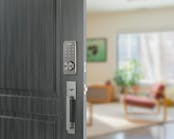An increased national focus on improving school safety and security has brought about some advances and innovations within locking and electronic access control systems, as manufacturers work closely with security and school professionals to provide the types of solutions they need, and that empower and bring peace of mind to teachers and students.
Locksmith Ledger held a webcast in June examining the state of security in both the K-12 and higher-ed areas, including looking at the latest recommendations for school and classroom doors and locks, the role of electronic access control in school security, the push to unify all life safety systems and technology, and the challenge security pros and schools have in obtaining funding and resources to get it all done.
The panel features Rick Fox, Life Safety and Access Control Manager, Colorado Mesa University, who leads the work group that supports the electrical, life safety and security systems on all of CMU's campuses; Guy Grace, Chair, Partner Alliance for Safer Schools (PASS), and National K-12 Director, ASSA ABLOY, who has served as the director of Security and Emergency Planning for Littleton Public Schools in Denver, Colorado, for more than 30 years; and Christopher Donohue, Eastern Director of Sales, Alarm Lock Division of NAPCO, who has more than 25 years in the electronic security working in access control, fire, CCTV, and security systems.
State of Security in Schools
Building a security plan for a school requires a comprehensive risk assessment and look at all areas and layers of a school, whether it is K-12 or higher-education, and implementing strategies and solutions that empower teachers, students and emergency personnel who may be responding to an incident.
“When we look at implementing life safety components in school, and school safety, for example, especially physical security components, access control is the foundation of that,” says Grace. “You're building upon that foundation while implementing life safety components into your schools.”
Grace points out that PASS (www.passk12.org) emphasizes all the key components of school safety, including locks and access control, alarms and detection, communications systems, human roles and processes, video management systems, enhanced lighting systems, etc., as well as other emergency components and unified life safety systems, in addition to the other types of new technologies that are being implemented on a regular basis.
For example, he notes that PASS is about to release its Tier 2 revisions recommending indicator locks (see page 10 for more on indicator locks) on classroom doors.
“When we look at that classroom layer, when the teachers and the staff are in those classrooms or they're going through their day-to-day processes, they're going through access control layers and those doors and that hardware empowers them to teach and it empowers them to learn,” says Grace. “It gives you peace of mind because there's a lot of fear whenever there's an incident in K through 12 or a national incident or any type of emergency situation, and they do have an impact on the psychological well-being of our staff and students.”
Fox agrees, adding, “Indicator locks are a huge improvement because that shows the status of the lock that they're trying to control. I am a believer in those communicating locks that have the indicating function.”
As Donohue points out, “It's all about empowerment of multiple users within your education environment. And unfortunately, or sadly, they may have to use those doors and hardware solutions in an emergency, but we don't want to turn the schools or the facilities into a prison, so it is striking that balance.”
Electronic Access Control
Another key area of focus at schools at all levels today is electronic access control, as it helps to unify classroom and exterior doors and locks with other key life safety and emergency notification systems, for example.
“When we look at electronic access control – that has such a huge empowerment function because you can keep the doors locked at all times and unify other technologies and functions such as hall passes as well as with your lockdown systems, your mass notification systems,” says Grace.
He adds that PASS has designated “unification” of systems as a foundational component in its guidelines, especially for the importance of being able to effectively communicate outside of the school, such as with law enforcement and emergency personnel.
At Colorado Mesa University, Fox has worked diligently to transition to electronic access control.
“How do you eat an elephant? A little bit at a time,” he says. “I've been here 18 years and every time we have a remodel, every time we do an improvement, you know I move into the next generation of technology and bring older systems up to date … and that's how I got to 100% [electronic access control] on the perimeter of all my buildings and 80% on the interior.”
Post-COVID, Fox points out that his campus is locked down when school isn't in session, because “every registered student, every faculty staff, every person who has a reason to be here has a site-specific encrypted credential that will allow them to move seamlessly everywhere they need to go.”
Like any other perceived amenity, he notes that having the latest and greatest in security technology not only keeps campuses more secure, but it can also help to attract new students, who are comparing all aspects of a campus experience when making that final decision of where to go.
“We need to stay cutting edge,” he says. “We need to move toward mobile credentials on my campus because that's going to be an expectation of that next generation of students. They are going to want the security and to be able to move seamlessly around campus, and into their classes, for example.”
He continues, “Short term, we still have a couple of thousand mag stripe blocks that have to go away before I can have a mobile credential in the Apple wallet, so that's absolutely our long-term plan. Of course, it is a substantial investment, but as I said earlier, at some point students aren't going to want to come to a place that doesn't offer that.”
And while electronic access control is being recommended and embraced on the K-12 level, upper-ed is leading the way in terms of adoption.
“We are seeing more traction in higher learning, which is more adoptive of a full access control system, as Rick alluded to with his facilities and his classrooms,” says Donohue. “In K through 12, we're seeing a lot more on the mechanical side in classrooms and not as much on the access control portion. We have seen some of the bigger school districts in the K through 12 changing more in that direction to electronic access control as far as the exterior doors.”
As he points out that there has been an overall increase in implementing access control on exterior doors to make sure those doors are locked and to monitor them locally, making sure they are not being forced open or held open in some way. “It relieves a lot of possibilities of human error of someone not making sure a door is closed or leaving a door propped open, and to make it easier for them to go in and out securely.”
Grace agrees that K-12 has been a bit slower to adopt electronic access control beyond the exterior doors but says that is changing as more awareness and funding becomes available.
“We're now starting to see more electronic access control, especially in the interiors and the corridors, in partitioning of a school,” he explains. “For example, if there's a lockdown using that electronic access control to lock off an area of the building from the intruder and keeping them from doing harm and maybe even confining them to an area, so you're starting to see that in the buildings.”
He continues, “We talked about this earlier, a unified life safety system, and when we are putting these electronic access control points in, we're [not only] facilitating the day-to-day business, but we're also facilitating the rest of the whole life safety components and unifying everything to work together for business and for emergencies.”
Vetting of Products
With so much attention on school security, decision makers are often overwhelmed by the technology options available, which makes the vetting of products so important, especially when you consider hidden or recurring costs or licensing fees, for example.
As Donohue points out, many schools feel pressured to run out and buy the newest shiny object, but it is important to work closely with the manufacturer to make sure that it is going to meet the needs of your school.
“It’s important for schools in both the higher education and that K through 12 to look at the products that people are pushing on them and to make sure that they're going to work and fit in their needs, because once you purchase it, you're kind of stuck with it,” he explains. “Always keep in mind, as you're moving forward, that recurring cost, the licensing fees for software, or if there are any kind of licensing fees for your VMS platforms, for example, could end up costing you much more in the long run.”
The panel is quick to point out that many manufacturers are happy to work with a school to let them try out products or systems to see if they fit their needs before making a large investment.
“It's been my experience that across all the manufacturers they are happy to let you give it a try, and they're happy to work with you and potentially customize things to meet your site-specific needs,” says Fox, noting that he had the opportunity to work with the industry and manufacturers in the design of the next generation of indicator locks.
Grace agrees that a pilot program can help a school find the right technology or solution and save them valuable time and funding by not making a mistake by choosing a product or technology that is not a good fit or will cost more in the long run.
“That pilot program is absolutely critical, but also to address the licensing costs we alluded to earlier – that's what eats up a lot of districts with budgeting,” says Grace, adding that he has seen licensing fees at three times the price of what the technology itself was to purchase.
Funding Hurdles
One of the toughest challenges for both K-12 and higher-ed is obtaining the funding to do what needs to be done.
Fox says, “What you need is a champion because the boots on the ground don't control the purse strings. Whether it's anecdotal or some other way, it is key to get someone at that higher level – on the school board or the highest levels of administration – to be your champion to help carry your funding request, which I am fortunate to have.”
He continues, “But none of that happens unless I do the groundwork and have someone who can convey it conceptually … see the importance the same way you do, you know that's key.”
On the K-12 level, Grace points out that there are some options for state bonds, grants and other funding.
“One of my functions in my work here is to analyze and help K through 12 to understand the funding, so we look at bonds and bond initiatives that are in communities, which are big sources of funding for K through 12,” he explains. “So, learn about what's going on in your state right now with funding, because when you're having contact with those K through 12 stakeholders, they might not be aware of that current state grant.”
Paul Ragusa | Senior Editor
Paul Ragusa is senior editor for Locksmith Ledger. He has worked as an editor in the security industry for nearly 10 years. He can be reached at [email protected].






